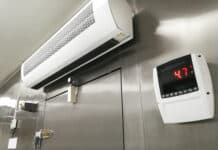
By Doug Baillie
From the April 2013 issue of Today’s Facility Manager
The cost of energy is not disappearing from the news, and today’s facility managers (fms) are on the front line of this important issue. “In these economically uncertain times, what we can be certain of is energy savings provided by today’s energy efficient technologies. Regardless of fiscal cliffs and sequesters, reducing energy costs and improving lighting quality—which creates high occupancy rates and increases worker productivity—will be the way the U.S. economy gets growing again and how American businesses will stay globally competitive,” advises Keith T.S. Ward, President & CEO of Luminus Devices, Inc., a Billerica, MA based maker of LED lighting.
In a February 2013 survey, TFM readers were asked about their recent and future lighting plans. In keeping with TFM’s reader profile, the majority of respondents represented high level decision makers. Thirty one percent indicated they make the final decision on lighting upgrades, and another 30% prepare the final proposal.
In terms of organization type, 78% of respondents manage commercial or institutional facilities, and 13% manage manufacturing buildings. Retail and other industries (e.g., worship, financial, arts/cultural) were also represented.
While 76% of respondents manage over 50,000 square feet of interior space (28.4% of those overseeing more than 500,000 square feet), 71% manage buildings older than 15 years, with 38% of that group managing facilities older than 30 years.

A recent analysis by McKinsey & Company and the International Energy Agency declared that lighting retrofits are the most cost-efficient way to combat climate change, save on power bills, and control expenses. So, what are fms thinking right now about lighting, and what are their plans to save energy and reduce operating costs? And what is the status of the lighting systems at their facilities?
Using TFM’s recent survey as a representative sample, 22% of America’s facilities have never undergone any type of lighting upgrade, or it has been more than 10 years since work has been done. If the University of Michigan estimate of five million commercial facilities in the U.S. is correct, that means 1.1 million are in serious need of new lighting systems. However, survey respondents also shared that 40% of their facilities had undergone lighting renovations within the last three years, down from 45% in a 2012 survey conducted by TFM. Meanwhile, 56% said they planned to renovate within the next three years, about the same as in the 2012 survey.
Fms have been paying attention to lighting issues, and their objectives for upgrading and renovating these systems are valid. As illustrated in Chart 1 below, the top four objectives that were rated “Very Important” in the survey were: reduce energy usage and costs (85.8%); lower maintenance costs (70.6%); improve light levels (51%); and increase occupant satisfaction (49.5%). This coincides with the fact that about half of respondents declared that lighting accounts for 20% to 40% of their electric bills.
Source Of Illumination
Linear fluorescent lighting is still the most prevalent interior light source, used in 86% of the survey respondents’ facilities. The most common lighting upgrade has been the change from outdated T12 bulbs to T8 (now used by 67% of fms responding to the survey). Compact fluorescent (CFL) lighting is used in 78% of buildings. The energy hogs, incandescent and halogen, are used in 49% and 36% of facilities respectively. Interior use of LEDs, which garner a good deal of current conversations about lighting, rose from 46% to 50% from the 2012 TFM survey. (See Chart 2 for more information.)
Outdoors, for wayfinding and security lighting, metal halide is the most preferred light source at 58.2%, followed by high pressure sodium (51%). New metal halide technology, featuring bright white light and increased energy efficiency, is clearly becoming more attractive to facility professionals. And LED usage moved from 24% (in the 2012 survey) to 30.6%, a significant increase driven by the increasing availability of outdoor retrofit lighting products. (Again, see Chart 2 for more information.)
Overall, 60% of those surveyed stated LEDs are used in some manner at their facilities. These are most commonly found in sign lighting (45%); exterior lighting (43%); and lobby lighting (39%). About one-third of responding fms stated they thought LEDs were too expensive or the technology was too new to specify. Very few were unaware of LED lighting, and 20% reported receiving a quote for LED lighting that was too high.
Light Control
In parallel with LEDs, lighting control technology is advancing at a rapid pace. Wireless dimming and control systems, including individual space control, can play a greater role in reducing energy use and improving the quality of light. Although 59% of the survey respondents said they use a “lighting management system,” the vast majority, more than 70%, employ sophisticated lighting control (multi-level switching and continuous dimming) in less than 25% of their space. The types of controls used are: motion sensors (71%); time switches (52%); and daylighting controls (35%). And 27% reported using a building automation system with integrated lighting controls.
Load shedding, a type of demand response, and called by some the evil twin of new lighting technology, is sometimes an option to reduce energy use, particularly where utility rates are high. In the survey, 14% of fms declared they have signed up to reduce demand in emergency situations, 18% say they are considering it, but 61% say they are not. The viability of load shedding is driven primarily by facility type, but as budget pressures increase fms should look at every option to avoid cost.
Missed Opportunity?
It appears the greatest lost opportunity in the history of facility management is that only 6% of responding fms report they have taken advantage of the Energy Efficient Commercial Building Tax Deduction (CBTD), and one third did not know about this federal incentive. Still, 40% stated they plan to take advantage of the deduction during 2013.
Part of the Energy Policy Act of 2005 (extended in 2008), the CBTD will expire at the end of 2013. It remains to be seen whether or not it will be replaced with similar legislation. (The National Electrical Manufacturers Association (NEMA) is working with the U.S. Senate on the Commercial Buildings Modernization Act.)
If the CBTD is extended, 30% of survey respondents indicated they would consider pursuing the deduction. The legislation provides for up to $.60/ square foot for lighting upgrades, and NEMA reports that many fms see paybacks of less than one year. When it comes to simple payback, 61% of survey respondents said they need a payback of less than three years, and 46% said the return on investment needs to be 25% or less.
Lighting upgrade investments are a great use of cash, particularly when interest rates are low. With that said, there is still time in 2013, and if a lighting renovation can be completed, the project may be eligible for the CBTD.
In addition to that federal program, many local utilities offer financial incentives to offset the cost of lighting upgrades and addition of load shedding equipment. Indicated in the survey, 61% of fms work with utilities that offer these incentives, and 50% say they plan to apply for incentives. And 22% have used incentives in the past.
The Green Pocketbook
This TFM survey concluded with questions about the relative importance of energy efficiency (with the resulting cost savings) and environmental impact. There, 51% of fms declared that energy efficiency is most important when it comes to their decisions about lighting upgrades, and 39% said environmental impact and energy efficiency were equally important. Only 2% said environmental impact was most important.
Regarding LEED (Leadership in Energy and Environmental Design), 5% of the respondents’ buildings were certified, 17% of fms said they were considering LEED certification, and 71% said they were not considering it.
TFM’s 2013 market research results were succinctly wrapped up by Michael Jouaneh, manager of sustainability and standards for Coopersburg, PA-based Lutron Electronics. “Lighting is the largest user of energy in commercial buildings,” he says. “So it’s important that building executives manage their lighting to save energy and money.”
Baillie held senior communications management posts at Siemens and Acuity Brands Lighting during a career that spanned four decades. He is still involved with several organizations in the lighting industry including NEMA and the National Lighting Bureau.























![[VIDEO] Collect Asset Data at the Speed of Walking a Building](https://facilityexecutive.com/wp-content/uploads/2024/02/maxresdefault-324x160.jpg)
Great article – unfortunately the pricing on LEDs is not quite financially viable yet, plus they emit a considerable amount of heat.
Short to mid term solution is T5 lighting and the T5 retrofit lighting adapter.